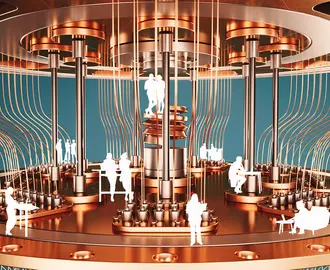For nearly 50 years, much of America’s growth has been concentrated in a handful of large and already prosperous coastal cities, widening the nation’s economic and cultural divides. Reversing this trend —and returning to the postwar prosperity that benefited far more Americans — will require an ambitious plan to boost public investment in scientific research and development in dozens of communities.
That’s the word from two MIT economists, Jonathan Gruber and Simon Johnson, in “Jump-Starting America: How Breakthrough Science Can Revive Economic Growth and the American Dream,” out April 9.
The plan is indeed ambitious: $100 billion in federal funding annually for research, with initiatives selected by an independent commission, located in underused federal buildings, creating four million jobs, and paying returns into a national endowment fund redistributed to all Americans equally, much like the Alaska Permanent Fund for distribution of oil revenues.
“So many good things can come out of technology development. We need to create very obvious win-wins,” Johnson, a professor at MIT Sloan, said in an interview. “Other countries are investing in public R&D. It’s not a zero-sum game, but there’s an advantage to being the first mover.”
Less investment, slower growth
Government funding for research and development rose steadily from 1940, on the eve of America’s entry into World War II, until the mid-1960s. At its peak, this funding amounted to 2% of the nation’s total gross domestic product per year — roughly $400 billion annually in today’s dollars.
By and large, Americans prospered as a result of this investment. GDP grew nearly 4% per year through the early 1970s; median family income doubled from 1947 to 1970. Research and development efforts during this time produced many innovations that are part of everyday life today, from GPS to memory foam to ultraviolet-reflective sunglasses to baby food. And, of course, they landed the U.S. on the moon.
“There’s a fantastic rate of return for the investment in science. It’s a big part of why the United States was so successful after World War II,” Johnson said. “Most people have forgotten that.”
Government investments in research and development started to stall in the mid-1960s — and through the eras of stagflation, Reaganonomics, the anti-tax movement, and the Great Recession, it has not recovered. Federal spending on R&D is now only 0.7% of GDP, or $240 billion per year less than its peak. Private investment in R&D has picked up, but investors tend to focus more on quick wins or sure bets for their own firms, and less on advances for the greater good, the authors note.
At the same time, annual GDP growth slipped to 3% in the 1970s and then to 2% in the early 2000s, while median family income has only increased 20% since the 1970s. Much of that growth has been concentrated on large cities on the East and West Coasts, leaving areas such as the South and Midwest behind.
“Reduced growth has reduced opportunities, and it has compounded other problems,” Johnson said.
From five “superstar” cities to dozens
Today, more than two-thirds of venture capital funding is concentrated in five urban cores: Silicon Valley, the New York City area, Greater Boston, Los Angeles, and Washington, D.C. These so-called “superstar cities” are also among the most expensive places to live in the United States, with some of the most restrictive residential zoning regulations. Fewer and fewer people can afford to live and do business there.
Gruber and Johnson advocate for locating new research centers in places with the potential to foster growth. The best candidates? Cities with a high concentration of educated young people, inexpensive housing, short commutes, low crime rates, and strong university science and engineering education.
“There’s a lot of potential to leverage other places. Not a lot of people are aware that there are many parts of the country with upside potential,” Johnson said, noting the recent emergence of R&D areas such as Central Florida and North Carolina’s Research Triangle Park. “Even Kendall Square was not a hub in the 1990s.”Using a model called the Tech Hub Index System, the authors rank 102 potential new technology hubs in the continental United States, in all regions of the country, ranging from major cities such as Houston and Dallas to mid-sized cities such as Logan, Utah and Appleton, Wis. The highest-ranking candidates are in industrial cities in the Northeast and Midwest.
At the Jump-Starting America website, an interactive feature allows users to see how changes in criteria changes the attractiveness of various places for technology development.
Taking advantage of the “spillover effect”
At 0.5% of GDP, a $100 billion publicly funded investment is significant. It will take political will and public persuasion for the plan to be put into action, Johnson said. The authors recommend multiyear appropriations, distributed by an independent commission, in order to avoid annual budgetary debate.
However, the authors note, cities and states already spend close to $50 billion in annual tax breaks to support private businesses. This leads to a “war among the states” for jobs that would stay within the United States, “and it feeds the backlash against business,” Johnson said.
“There’s a feeling of distrust with the corporate sector, which is really unfortunate,” he added, noting the backlash surrounding Amazon’s plans to put its second headquarters in New York City and the Washington, D.C. area. “We should try to find other ways to move forward. That distrust does not lead to good policy.”
On the other hand, public investments in research and development contribute to what the authors call the “spillover effect.” When the product of the research is not a private firm’s intellectual property, its impact flows across the economy.
For example, the government’s $3 billion investment in the Human Genome Project in the 1990s has led to the creation of an industry that generates nearly $6 billion in federal, state, and local taxes per year. Areas of focus for future investment could include synthetic biology, hydrogen power, and deep-sea mineral exploration, the authors said — areas where countries ranging from China and Japan to Canada and the United Kingdom have taken a lead while U.S. investment has stalled.
The role for the private sector is twofold, Johnson said: “Get in early” on research partnerships and invest in new technology hubs outside the superstar cities.
“It’s in everyone’s interests to have the next big push,” Johnson said. “We need 20 programs like the Human Genome Project every year — not one every 20 years.”



